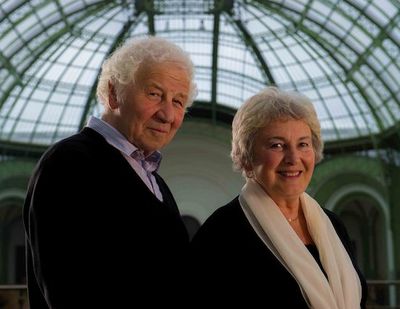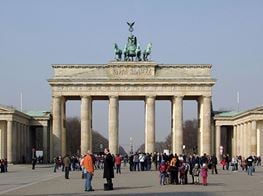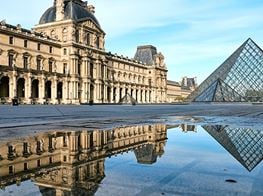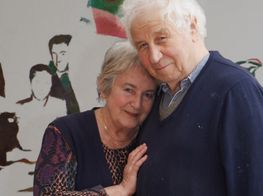Ilya And Emilia Kabakov

In 2014, Monumenta’s sixth edition was presided over by Russian-born artists Ilya and Emilia Kabakov. Celebrated internationally for their large-scale projects and ambitious installations, the Kabakovs used the invitation by Jean Paul Cluzel, president of the RMN, (the Réunion des Musées Nationaux), who oversee the commission and production of Monumenta each year, to transform the Grand Palais in Paris into what they called ‘The Strange City’ – the maze of an imaginary town designed to engulf viewers in a journey designed to ignite memory. In this interview, the Kabakovs talk about the work and the ideas that fed its conception.
What prompted you to create a utopian city within the Grand Palais for Monumenta 2014?
The idea of creating a parallel world is at the heart of every one of the seven spaces we built for ‘The Strange City’. They are worlds which will be completely separated from our own everyday reality, and the 'City' as a whole, because of the walls surrounding the inside space which will form such separation.
How did the context of Paris feed into the Monumenta project, and further to this, how important is context when producing work for different spaces, institutions or projects?
The context of the space, city and museum is always very important to us, especially at The Grand Palais. The Grand Palais itself is a separate world inside of Paris, and our ‘city’, is also the same kind of ‘separate world’ inside of the Grand Palais. Every time we worked on the installation, we were spending time inside the city, inside the building, inside the space, trying to feel the atmosphere and the attitude of the people living or visiting those parks, museums, streets, spaces. This is crucial to producing artwork that resonates with the people.
How does this project tie in with your wider approach in terms of producing environments that blend the everyday with the conceptual?
Russian conceptualism as it is perceived by the West, and understood by the Moscow Conceptual School, is the production of strange, individual projects. However, every day we can still observe someone’s individual project as strange and very conceptual. Therein lies the similarity.
There is of course a sense of Soviet Constructivism in this project for Monumenta, in that you are taking into account the building's history, and its monumental glass ceiling, as a starting point to imagine a contemporary utopia... how does this symbolic world express the way you perceive the twenty first century as it stands, and in relation to the legacies of the twentieth Century?
The twenty first century is the movement to the future, but one that may look back into the twentieth and nineteenth centuries, and so on. In our work, we consider ideas that were here long ago, and Constructivism is one of these ideas.
Could you expand on these ideas that bridge a movement to the future with a recollection of the past in the case of ‘The Strange City’?
There are quotations of certain ideas, books and visual images from the cultural history of art, literature and even music, presented alongside some from the present, and proposals for the future.
You state that this edition of Monumenta will offer the visitor 'a journey of initiation and a reflection on the human condition' – could you describe this journey?
This journey asks the visitor to reflect on many aspects of memory: private, personal and collective. It will at times remind the visitors of a book they read as a child or indeed the book that they are now reading once again.
I wonder how this project might connect to the installation you produced: The Red Wagon, which attempted to represent, depict or induce the memory of 'Soviet time' from its first to its last moment? On the project, you questioned how one might represent Soviet history visually, and decided that it would be best portrayed as a kind of 'bridge' or arc.
There is no connection with The Red Wagon. The Red Wagon was an attempt to create a metaphor for the history of the Soviet Union from its beginning to its end. The Strange City is not about local, but universal ideas and problems.
But what kind of bridge or arc you are producing in Strange City with regards to the history, legacy and future of the urban environment, the city, or the metropolis as a universal space?
We don't really talk about the urban environment or the city literally speaking. It is more of a fantasy, a concept of ideas, like an identical city existing on another plain, or another reality that we can only see if we go to a certain place on a certain mountain. It is about the cultural legacy of humanity, which is preserved not only in museums but also in our mental memory. We are not trying to teach or prophesize. We are not prophets, or teachers. We offer the viewer a general idea: what if, or: maybe, or: somewhere at some time...And the viewer has to decide by himself or herself what personally they see or visualize beyond these fantasies or images.
When you look back on your careers as artists, what are the biggest developments and changes that have taken place in the art world, from your perspective?
In our opinion all radical changes can be dated from the year 2000. Before that date, idealistic and elevated ideas dominated the art world because of the importance placed on museums and non-profit spaces, whose directors and curators were influencing the climate both inside and outside the art world. The art world – including most of the collectors – was breathing such air and consequently the commercial aspect was mostly hidden. Then, the ship was turned upside down and the bottom became the top, so all material became about ‘The Art of the Deal’ or ‘Deal of The Art’.
What have been some of the more memorable moments in your career, either in terms of projects you have undertaken, events you have visited, or people you have met?
We were lucky to meet a lot of great people who influenced not only us personally, but also the art world as a whole. These include: Jan Hoet, Jean Hubert Marten, Carl Zeaman, Dominic Bozo, Robert Storr, Gerard Mortier. Sadly some are not with us anymore, but others are still working. As for the events, the destruction of the Soviet Union, the fall of the Berlin Wall and September 11th, 2001. Those are the most defining moments of the 20th century, which left a very deep, albeit different impression not only on us, but on humanity as a whole. ― [O]













































































































































































